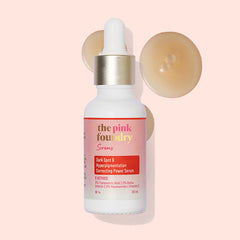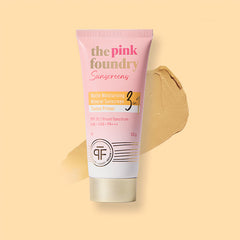Blemished skin: Meaning, types, and prevention tips
Have you ever looked into the mirror after a long shower and found those weird spots, marks, and discolourations on your clear skin? You're not alone. Millions around the world are afflicted with blemished skin—regardless of age or skin type. These imperfections can be frustrating, but knowing what makes them happen and how to deal with them makes all the difference.
So let’s explore all you ever needed to know about blemished skin — from what it looks like and what causes it to how you can actually fix it!
What is blemished skin?
When we talk about blemished skin meaning, we're referring to any type of mark, spot, or discolouration that disrupts your skin's natural appearance and texture. Blemishes are irregularities that show up on your skin like a canvas, and it’s just a matter of internal and external factors.
Blemishes meaning on face can encompass various skin concerns, from temporary redness to more persistent issues like acne scars or dark spots. These marks are found anywhere on your body but will show up most on your face. Blemished skin is very challenging to deal with because it’s not just a superficial issue; it can really be an issue that affects how you present yourself in the world and how you feel about yourself. The good news? There is a right way of treating most blemishes.
Why do you get blemishes on your face?
- Hormonal Fluctuations: Skin health is largely in your hands (specifically, hormones). During puberty, menstruation, pregnancy, or times of stress, hormonal changes can trigger excess oil production, leading to various types of skin blemishes and breakouts.
- Environmental Aggressors: Pollution, UV rays, and other environmental factors can damage your skin barrier daily, resulting in oxidative stress and inflammation. And often, this leads to dark spots, uneven texture, and other blemishes.
- Lifestyle Habits: You might be surprised to learn that your daily routine matters more than you think. Blemish skin results from poor sleep habits, touching your face often, dirty makeup brushes, or not taking off makeup before bed.
- Diet and Hydration: Your skin shows what you eat. Skin imperfections and blemishes can be caused by a diet consisting of processed foods and sugar and insufficient water intake.
- Genetics and Skin Type: Your genetic makeup can sometimes determine how prone you are to some blemishes. Knowing your skin type will determine which treatment approach is best for you.
- Medication Side Effects: As side effects, some medicines, such as corticosteroids, birth control pills, and certain antidepressants, can cause skin changes and blemishes. If you start a new medication, always discuss potential skin-related side effects with your healthcare provider.
Different types of skin blemishes
Inflammatory blemishes
- Papules: Red, raised bumps that feel tender to touch, small. They result from the breakdown of pore walls due to inflammation.
- Pustules: These red bumps with visible pus at their centre are also called classic pimples and indicate active infection within the pore.
- Nodules are deep under the skin and have huge, painful bumps lasting for weeks. However, scarring often requires professional treatment.
- Cysts are the most severe form of inflammatory blemishes, painful deep lesions containing pus and other fluids. They have the greatest risk of scarring and usually require medical treatment.
Non-inflammatory blemishes
- Blackheads: These are open comedones where the pore is still open, so the contents can oxidise and appear dark. Contrary to popular belief, black isn’t dirt; it’s oxidised oil and dead skin cells.
- Whiteheads: Small, flesh-coloured bumps under the skin; they are closed comedones. The pore opening is blocked to prevent oxidation of contents.
- Post-Inflammatory Hyperpigmentation: Patches that remain after the blemishes caused by inflammation heal. The marks can be pink to brown, and they last months and fade naturally.
- Melasma: These brown or greyish symmetrical patches are often called the 'pregnancy mask' and tend to appear on the cheeks, forehead, and upper lip. Hormonal changes and sun exposure trigger them.
Also read: Understanding the causes of melasma
Additional blemish types
- Milia: Tiny, hard, and white bumps occur when keratin becomes trapped beneath the skin's surface. Common around the eyes and cheeks.
- Sun Spots: These flat, brown-coloured spots, usually due to cumulative sun exposure over time, are also called age spots or liver spots.
- Sebaceous Hyperplasia: Enlarged oil glands causing small, soft, yellowish bumps. Above all, they are more common in mature skin and can be confused with whiteheads.
How to prevent different types of blemishes on face
It’s always better to prevent the blemishes than to cure them! Begin with a cohesive skincare regimen of gentle cleansing and consistent exfoliation. The Dark Spot & Hyperpigmentation Correcting Power Serum from the Pink Foundry prevents and treats stubborn dark spots and uneven skin tone.
The Pink Foundry Dewy Hydrating Hybrid Sunscreen SPF 50+ not only protects your skin from UV damage but also prevents current blemishes from darkening.
Always keep your hands away from your face, and wash frequently things you touch your skin, like phone screens and pillowcases. The best results come from a holistic approach of good skincare products, healthy habits, and routine.
Also read: What are the best ways to remove face blemishes
Conclusion
Understanding what is blemished skin and its various manifestations is your first step toward achieving clearer, healthier-looking skin. Blemishes can be annoying, but remember that most are temporary and treatable. By following the correct combination of targeted skincare products, good habits and waiting, you can lessen their appearance and avoid future appearances. So, begin your journey to clearer skin right now.
FAQs
Q1: How long until the blemish fades?
A: The healing time varies, depending on what kind of blemish it is. Deeper blemishes, however, will take 4-6 weeks to heal completely, while surface-level spots might only last a few days.
Q2: Can stress make your skin blemish?
A: Stress actually triggers hormonal changes that cause oil production and inflammation, leading to different types of blemishes.
Q3: Are all blemishes actually considered acne?
A: Acne is literally one form of blemish, but not all blemishes are acne. The blemishes include dark spots, scars, hyperpigmentation, etc.
Q4: Can skin blemishes be affected by diet?
A: Of course, some foods, such as foods that are high in sugar and dairy products, may aggravate or make skin blemishes worse in some people. Eating a healthy diet that contains antioxidants may improve your skin's health.
Q5: Should I pop my blemishes?
A: No, popping blemishes can leave you with scarring, infection, and slow healing time. Targeted treatments are better than ones that let them heal naturally.










